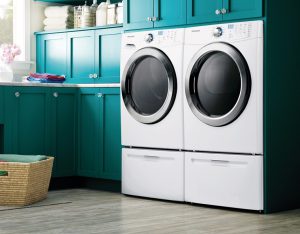The Vent is Blocked
The most common reason why a dryer may not be heating is that the vent is blocked. To check if your dryer venting is clogged, start a high heat drying cycle. Go outside your home and look at the outdoor exhaust vent. Place your hand in front of the vent to feel if the air from the vent is warm and flowing at a good rate. If there is little airflow, the vent is likely to require cleaning or even replacing. If the air feels cool, it is possible that there is an issue with your dryer that will need to be checked by a professional service technician.
Improper Energy Supply
The next thing to check is that there is a proper gas or electric supply to your appliance. Dryers obtain electricity from a 240 volt circuit that is supplied by two 120 volt power lines. If one of the lines isn’t working properly, the dryer may still run, but it will not heat properly. If the gas supply to the appliance is off, your dryer won’t heat up. Both of these issues need to be checked by a professional appliance repair technician to ensure that the appliance is operating safely.
Dirty Lint Screen
Another common cause of dryer problems is a dirty lint screen. When the screen is plugged up with debris, airflow is reduced, and this will prevent your clothes from drying properly. You should clean the lint screen after each load, but if your screen is clogged, you’ll need to remove as much of the lint as possible and soak the screen in soapy hot water. If necessary, you can use a soft toothbrush to scrub your screen gently. Ensure that the screen is thoroughly dried before replacing it in your dryer.
Your Load is Uneven
If you’re continuing to have drying issues, you need to look at what you’re drying. If you’re mixing large and small items, it can create a drying problem, particularly if you have an auto dry cycle. When you put items such as sheets or towels together, the dryer may heat at lower levels and could even shut off. This means that while your lighter clothes and smaller items are properly dry, the heavier, larger items are still damp.
Your Washer’s the Problem
If you’ve been through this troubleshooting list, it may be time to look at your washing machine. If your clothing is still wet after a drying cycle, it might not be because your dryer is faulty, it could be a washing machine issue. If your washing machine is not spinning properly or draining completely, it makes it harder for the dryer to perform its task. Don’t just put your clothing straight in the dryer, check it as it comes out of the washer. If your items are dripping wet, there is a washing machine issue that needs to be addressed.
There is a wide variety of issues that can affect your dryer’s performance and educating yourself on these problems can help you to obtain maximum functionality from your appliance. For practical advice, you can rely on a professional home appliance repair technician to help you.
For help will all of your dryer repair issues, be sure to speak to a professional appliance repair service.
